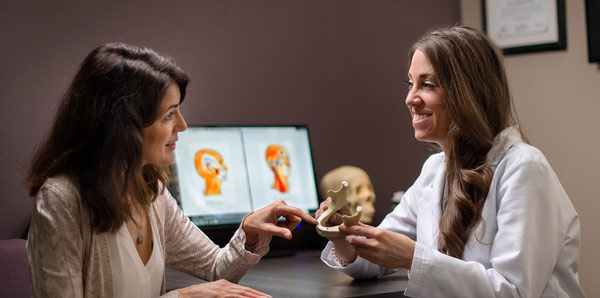It’s not uncommon to experience weird side effects when you have temporomandibular joint (TMJ) disorder. Things like popping and clicking jaws, ringing ears and migraine auras are all par for the TMJ disorder course. But one symptom often causes more alarm than others: bumps or lumps under the jaw.
Keep reading to learn more about how bumps under the jaw are related to TMJD and how TMJ treatment in Pittsburgh can help.
Different types of bumps under the jaw
Bumps under the jaw can be a very alarming discovery. But if you have TMJ disorder, chances are, you don’t have much to worry about. That’s because bumps under the jaw are quite common with TMJ disorder. But what are they?
Lymph Nodes
Lymph nodes are part of the lymphatic system. Their purpose is to trap viruses and bacteria that could otherwise make you sick. When your lymph nodes swell, chances are your body is fighting off an infection. This is known as lymphadenitis. Very rarely, swollen lymph nodes can be caused by cancer, but usually, they are harmless. Still, be sure to have them checked out by a physician as soon as possible.
Cysts
A cyst is a sack of air or fluid inside the body. Usually, they are benign (not cancerous), but in some very rare instances, they can be cancerous. Just like with lymph nodes, it is important to have a doctor or dentist check out your cyst to be safe.
Saliva Glands
Your salivary glands are where your body produces the saliva that keeps your mouth moisturized and helps prevent cavities. Sometimes salivary glands can become infected, causing them to be swollen and painful.
What is temporomandibular joint disorder?
TMJD affects over 10 million Americans and can be very uncomfortable and painful. It’s a condition when either one or both of your TMJ joints are swollen due to the jaw shifting from its original position. The leading causes of TMJD are an excessive strain on the jaw joints from bruxism (teeth grinding), trauma to the jaw, head, or neck, genetics, arthritis, disease, and injury.
Some symptoms of TMJD include:
- Pain in the jaw, neck, face, shoulders, and ears when you talk, eat or open your mouth
- Difficulty opening your mouth
- Jaw gets “locked” in certain positions
- Popping or clicking noises when you speak or chew
- Facial soreness
How TMJ treatment can help
While TMJ disorder won’t cause bumps, the presence of these usually benign bumps can make TMJ disorder symptoms worse. The pain and swelling put additional pressure on the surrounding tissue that may already be in pain due to the TMJ disorder.
Dr. Alexandra S. George DDS treats TMJD with:
- Orthotic appliances – Removable appliances are semi-permanent solutions that move the lower jaw in its proper neuromuscular position. They can be worn 24 hours a day and helps reduce painful TMJD symptoms.
- Crowns – Like an orthotic appliance, crowns restore your teeth to a pain-free position. Unlike orthotics, they are not removable and come in full crowns to restore the entire mouth or partial crowns to restore specific areas. Crowns are ideal for patients who grind their teeth – as a bonus, crowns give you a beautiful, bright smile.
- Braces – Braces for treating TMJD are not your typical braces. Instead of focusing on just how your smile looks, the objective of braces for TMJD is to move the teeth and remodel your jaw and bone structure to how they should function.
- DTR Therapy – Using advanced Tekscan and EMG technology, we can perform accurate micro-adjustments to achieve a better-balanced bite. The result is relief from painful TMJD symptoms and a more functional bite overall.
If you have TMJ disorder and are feeling bumps under the jaw bone, please contact our office to schedule an appointment as soon as possible.


